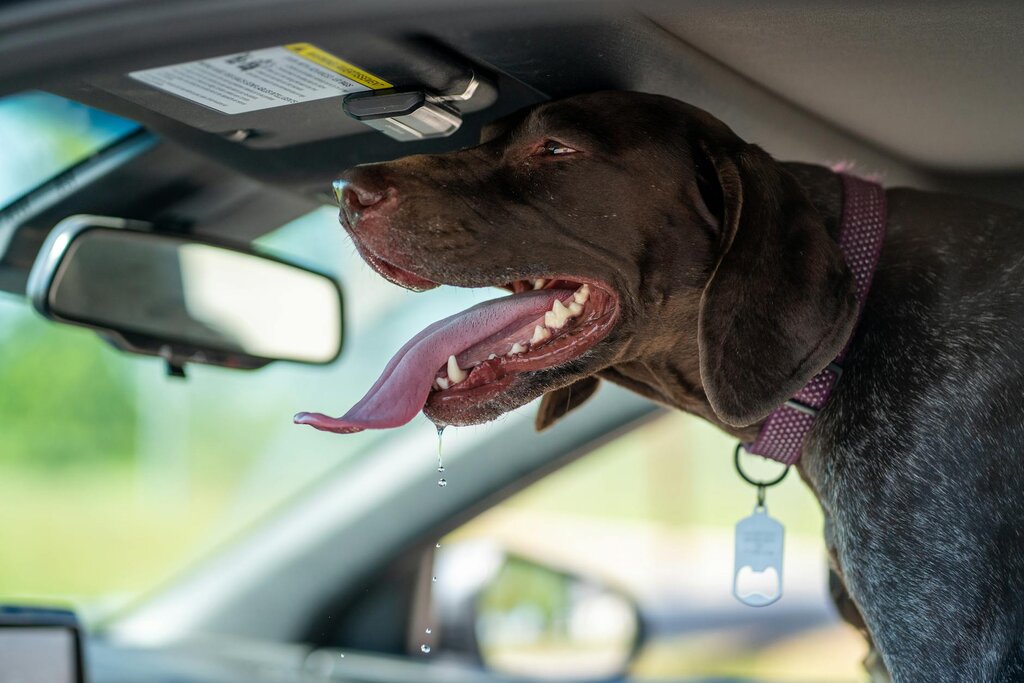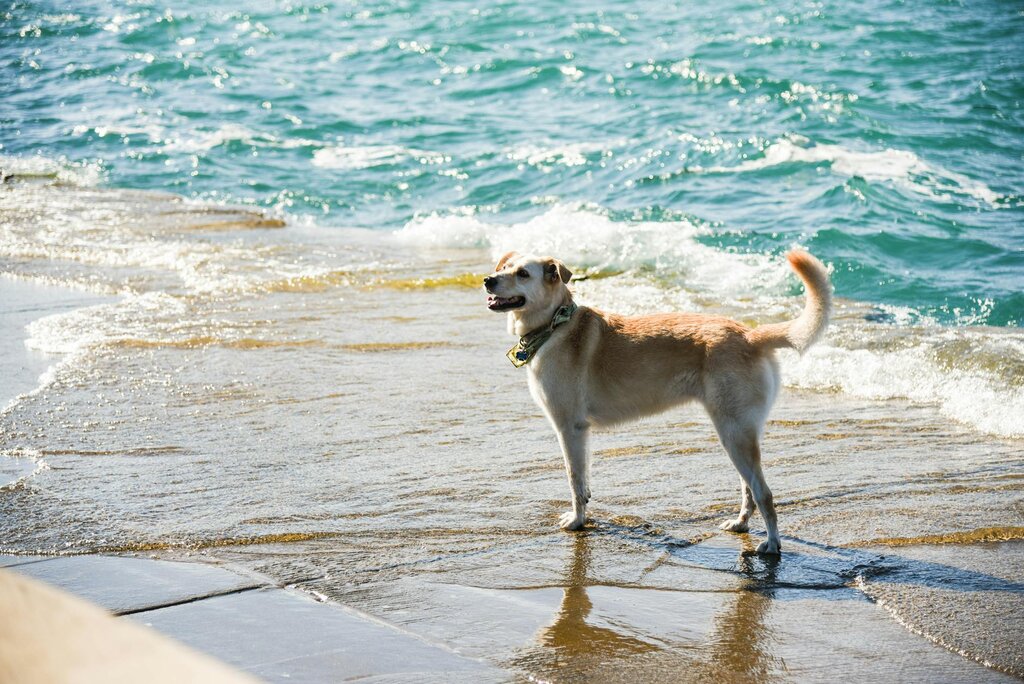Last Updated: 13/11/2025
Heatstroke in Pets: A Vet's Guide
This essential guide from our vet team explains everything you need to know about heatstroke. Learn how to identify the critical signs and what immediate steps to take. Discover practical prevention tips, including proper hydration, walking schedules, and sun protection for at-risk pets.
Author: Dr Carla Paszkowski BVSc (Hons)
Reading Time: 9 minutes - short read
Summer in Australia brings fun in the sun, but the scorching weather can be dangerous for our pets. While we know how to 'slip, slop, slap' to protect our own skin, our furry friends rely entirely on us to keep them safe from the heat. Being prepared is the key to preventing serious conditions like heatstroke.
This guide covers what you need to know to keep your best mate safe all season long.
What are the signs of heatstroke in pets?

Pets that are at a greater risk of heat stroke include long or dark-haired, overweight, and brachycephalic (flat-faced) breeds. However, every pet is at risk of developing heat stroke during extreme heat, particularly if they are heavily exercised or unable to cool themselves adequately.
Unlike humans who sweat to cool down, pets primarily rely on panting. If they can't cool down effectively, their body temperature can rise rapidly. Early recognition is key to a positive outcome.
Common signs of heatstroke include:
- Excessive, rapid, or noisy panting
- Thick, sticky drool or saliva
- Bright red or bluish-purple gums and tongue
- Weakness, dizziness, or stumbling
- Vomiting or diarrhoea (sometimes with blood)
- Restlessness or agitation
- Muscle tremors
- In severe cases, collapse, seizures, or loss of consciousness
What should I do if I think my pet has heatstroke?

Heatstroke is a life-threatening veterinary emergency. If you suspect your pet is suffering from it, follow these steps immediately.
Immediate First Aid:
- Move your pet out of the heat and into a cool, shaded, or air-conditioned space.
- Place them in front of a fan to increase air circulation.
- Gently wet their hair and skin with cool water (not cold or icy), avoiding their face, or wipe them with damp, cool towels, focusing on the neck, armpits, and groin area where major blood vessels are close to the surface. Do not cover them with a wet towel or cloth as this will absorb the heat from their body and create humidity, further raising their temperature.
- Offer small amounts of cool water to drink, but do not force them.
- Call your vet or the nearest emergency clinic immediately. Let them know you are on your way with a suspected heatstroke case. Continue cooling measures during transport by running the air-conditioning.
What to Avoid:
- Do not use ice or ice-cold water. Cooling your pet too quickly can cause shock and other serious health complications.
How can I prevent my pet from getting heatstroke?

1. Create a cool zone: shade and shelter for pets
Your pet will moderate their own temperature if given access to cooler areas, such as shady patches. If your pet is outdoors only, you might like to supply a shade shelter or kennel so they can cool down on hot days. You also might like to consider a pet access door so your pet can go inside for shade, or outside for some fresh air as they please. For indoor-only pets, always make sure the home is well-aerated during the day if left home alone.
Bring smaller pets indoors
On very hot days, move rabbit hutches, guinea pig cages, and bird cages into a cooler, well-ventilated part of the house.
2. Keep your pet hydrated
While excessive temperatures certainly do a lot of damage, most heatstroke symptoms are actually related to severe dehydration. It's always important to keep your pet hydrated during summer, and there are plenty of ways to achieve this. You can encourage your pet to drink with a water fountain, as pets are naturally attracted to running water. You can also try freezing a block of ice with some treats or minced meat inside, as a make-your-own 'doggy ice block'.
If you are taking your dog out for some outdoor activity, always think ahead and consider bringing a travel water bottle so you can provide water on the go.
Shade and hydration essentials
3. Exercising your dog safely in the heat
To avoid over heating your pooch, only walk them early in the morning or late in the afternoon or evening. This is particularly important for those brachycephalic (flat-faced) breeds who struggle to breathe when exercised in the heat. Remember: dogs regulate their temperature by panting. If a dog can't breathe properly, they also can't cool down.
In addition, be mindful of hot surfaces. Pavement, sand, and ute trays can burn your pet's paw pads. If it's too hot for your hand, it's too hot for their paws.
Why not look at some night walking products and tips, to get you motivated for some moonlight strolls?
4. Too hot to walk? Try swimming and water play
Sometimes, it's just too hot to walk your dog. But that doesn't mean they have to miss out on their daily exercise. Why not take them swimming?
Swimming is an excellent low-impact form of exercise for dogs (just as it is for us!) and particularly good for dogs with arthritis or weight issues. If you don't have a pool or dog beach nearby, why not try a portable dog pool? You can even kit them out in a doggy life jacket if you aren't sure how sound their fitness is!
Exercise and play essentials
5. Use cooling mats and gear to keep your pet comfortable
There are plenty of products that can help keep your pet cool, particularly if you aren't home with them during the day. Cooling mats can provide a refreshing cool surface for your pet to lounge upon, and chilled bowls can help keep their water source icy fresh. Cooling bandanas are even available, which keep your dog 'cool' in more ways than one!
6. Manage your pet's coat
For cats or dogs with long coats, such as poodles or ragdolls, ensure you get them clipped nice and early in the season to avoid excessive shagginess and overheating. It's also important to keep them brushed and well-groomed to avoid extra mats. After all, no one would make you wear a winter coat during summer, so why should it be any different for your pet?
Cooling and grooming essentials
Never, ever leave your pet in a car. Not even for a minute. The temperature inside a car can become lethal in a very short amount of time.
For further guidance, please read our guide on What to do if you see a dog locked inside a hot car.
Sun Protection for Pets

Just like us, our furry friends can suffer from sunburn. Sun exposure can cause uncomfortable, painful lesions and may lead to more serious conditions like skin cancer. Understanding the risks and taking preventative measures is the best way to keep your pet safe in the sun.
Pets most at risk of sunburn:
- Fur and skin colour: Pets with white or light-coloured fur are more susceptible due to lower pigment levels in their skin.
- High-risk breeds: Breeds particularly at risk include bull terriers, border collies, boxers, dalmatians, greyhounds, whippets, and staffies..
- Vulnerable areas: The most common spots for sun damage are those with less fur coverage, such as the ears, eyelids, nose, and belly.
How to protect your pet from the sun:
- Avoid peak UV times: The best prevention is avoidance. Keep your pet indoors or in a well-shaded area during the hottest part of the day, typically between 11 am and 4 pm.
- Use pet-safe sunscreen: When your dog will be in the sun, apply a dog safe sunscreen specifically formulated for dogs to vulnerable areas.
- Cover up: For pets who love to be outdoors, a UV-resistant sunsuit can be a great option. Remember to still apply sunscreen to their exposed ears and nose for complete protection.
FAQs
With our hot Australian summers, keeping your pet safe from the heat is a top priority. Simple steps like providing constant access to shade and cool water, walking only during the coolest parts of the day, and never leaving your pet in a car can make all the difference.
Recognising the early signs of heatstroke and taking immediate action is critical. By being prepared and proactive, you can ensure that you and your best mate have a fun, happy, and safe summer together.
Articles recommended for you
Our vet authored guide to the benefits of feeding your dog fresh food plus tips and advice for introducing it into their regular menu.
See our guide to protecting your pet from parasites from our vet team.
Thinking of getting a fish? Check out our guide for setting up a tank and home care tips!
Looking to understand horse feeds better? This comprehensive guide covers feeding recommendations for horses of all ages and disciplines.
Does your pet suffer from anxiety? Check out our Vet-guide for treatment options to help your pet.
History
Our experts continually monitor the health and wellness space and we update our articles when new information becomes available.
Tue 23 Sep 2025
Edited by Dr Gillian Hill BVSc (Hons)Dr Carla Paszkowski BVSc (Hons)
Veterinarian
Dr. Carla graduated from the University of Queensland in 2013 with a Bachelor of Veterinary Science and worked for a number of years in small animal clinics across South East Queensland. While Carla enjoys most facets of clinical veterinary work, she holds a special passion for feline medicine, pocket pets, and nutrition.

